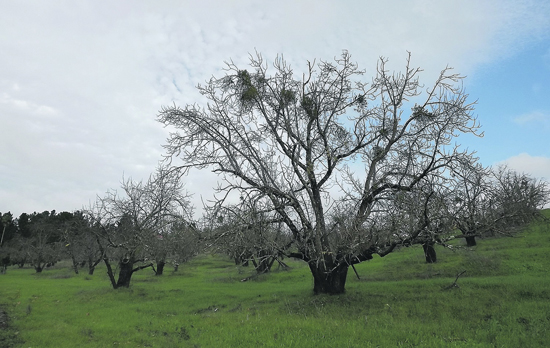 | | | A grove of trees in Moraga sport mistletoe in their branches. Photos Cathy Dausman
| | | | | | Kissing couples seek it out at Christmas, but pity the poor Lamorinda tree playing host to mistletoe. Nat King Cole may have waxed poetic about enjoying turkey and some mistletoe, and Justin Bieber sings about being under the mistletoe, but mistletoe, like the local wild turkey, is actually a pest-a parasite.
 Okay, it's technically only hemi-parasitic, which means that it actually can exist on its own, although like an unwanted holiday guest it probably prefers to mooch off the nearest host-tree.
Okay, it's technically only hemi-parasitic, which means that it actually can exist on its own, although like an unwanted holiday guest it probably prefers to mooch off the nearest host-tree.
 Tumbleweed-sized mistletoe clumps are common in local tree groves, and are easily visible when deciduous trees shed their leaves. The Anglo-Saxon roots, "mistel" and "tan," literally meaning dung and twig, explain just how unromantically the shiny green parasite transfers from bird food to droppings to tree branch.
Tumbleweed-sized mistletoe clumps are common in local tree groves, and are easily visible when deciduous trees shed their leaves. The Anglo-Saxon roots, "mistel" and "tan," literally meaning dung and twig, explain just how unromantically the shiny green parasite transfers from bird food to droppings to tree branch.
 Once established, mistletoe saps water from the tree, either stunting its growth or eventually killing it. A U.C. Davis pest management website describes several kinds of common broadleaf mistletoe in California. One affects trees including alder, flowering pear, ash, birch, walnut and cottonwood; another variety infests only oaks. A third variety is endemic to Sonoma County. There are even mistletoe varieties which infest fir trees and conifers in the Sierra Nevada Mountains and foothills.
Once established, mistletoe saps water from the tree, either stunting its growth or eventually killing it. A U.C. Davis pest management website describes several kinds of common broadleaf mistletoe in California. One affects trees including alder, flowering pear, ash, birch, walnut and cottonwood; another variety infests only oaks. A third variety is endemic to Sonoma County. There are even mistletoe varieties which infest fir trees and conifers in the Sierra Nevada Mountains and foothills.
 Just how did the kissing ritual associated with mistletoe begin? In ancient times, mistletoe signified life, fertility and forgiveness. The Greeks believed it protected them from evil spirits, and armies or angry spouses in Scandinavia could declare a truce underneath what they considered a plant of peace. In 18th century England, a young woman found beneath a mistletoe ball could not refuse to be kissed; if she rebuffed a suitor, she'd remain unmarried throughout the New Year.
Just how did the kissing ritual associated with mistletoe begin? In ancient times, mistletoe signified life, fertility and forgiveness. The Greeks believed it protected them from evil spirits, and armies or angry spouses in Scandinavia could declare a truce underneath what they considered a plant of peace. In 18th century England, a young woman found beneath a mistletoe ball could not refuse to be kissed; if she rebuffed a suitor, she'd remain unmarried throughout the New Year.
 Mistletoe has also been used since ancient times to treat illness. Even today its mystical powers persist. The National Cancer Institute says mistletoe is used to treat cancer, most commonly in Europe. So whether it makes you feel good or just makes you feel romantic, we bet you'll never look at mistletoe the same next year!
Mistletoe has also been used since ancient times to treat illness. Even today its mystical powers persist. The National Cancer Institute says mistletoe is used to treat cancer, most commonly in Europe. So whether it makes you feel good or just makes you feel romantic, we bet you'll never look at mistletoe the same next year!

|

